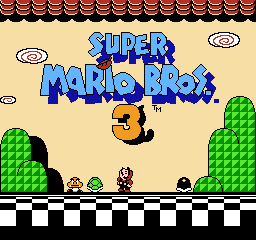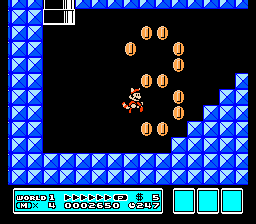Overview
 The title screen.
The title screen.Released in the United States in 1990, Super Mario Bros. 3 was one of the most highly anticipated games of its time. Nintendo's promotional campaign leading up to the game's release was unprecedented for a video game in the US, and included a key role in the climactic moments of the video-game-themed movie The Wizard. While the film was universally panned by movie critics and video gamers alike, it was successful in its ulterior purpose of promoting Super Mario Bros. 3.
Super Mario Bros. 3 is generally considered to be one of the Nintendo Entertainment System's best, one of the greatest Nintendo games of all time, and also one of the best Mario games ever created. It was noted for being the top selling video game of all time, before being surpassed by Wii Sports.
The game's popularity has resulted in a few ports and remakes, including Super Mario All-Stars (a compilation of early Mario games), Super Mario Advance 4: Super Mario Bros. 3, and a Virtual Console port.
Shigeru Miyamoto returned as lead designer along with Takashi Tezuka, and Koji Kondo as the game's music composer.
Gameplay
 Super Mario Bros. 3 brings back the series' traditional gameplay.
Super Mario Bros. 3 brings back the series' traditional gameplay.The gameplay in Super Mario Bros. 3 is more akin to the original Super Mario Bros. than the deviation found in Super Mario Bros. 2. The game also expands on and introduces many new concepts, some of which stayed for future Mario titles. Notably, Super Mario Bros. 3 was the first Mario game to feature a world map, allowing the player a certain level of freedom, including the occasional opportunity to skip sections of levels.
The game follows the traditional formula of Mario chasing down Bowser to rescue the kidnapped Princess Peach, though this time around Mario also has to deal with Bowser's children and their powerful airships.
Because of the new world map, certain areas are blocked by Hammer Bros., which Mario must defeat (or he can put them to sleep using an item found in the game). Along with these dangerous obstacles, there are minigames found in a Toad's house. The minigames allow Mario to win items such as Super Mushrooms that can be stored in a bar at the bottom of the screen for future use in individual levels.
Super Mario Bros. 3 also includes a simultaneous multiplayer mode. Player one controls Mario while player two controls Luigi, as the two traverse the game's eight worlds. Through this mode, even more minigames are accessible, including a retouched version of the original Mario Bros.
Worlds
 Grass Land is the first world.
Grass Land is the first world.- Grass Land (World One) - Grass Land is a basic Mario world, featuring a mix of slightly varied Mario environments such as straightforward outdoor stages, auto-scrolling stages that take place in the air, and even an underground stage. It is the smallest world in the game, its map taking up only one screen.
- Desert Land (World Two) - A desert world, as the name implies. Quicksand becomes a common obstacle, and one stage takes place inside of a pyramid.
- Water Land (World Three) - This world takes place next to the ocean. Levels begin to take place underwater, and even levels that are not underwater usually feature water of some kind.
- Giant Land (World Four) - Giant Land is very similar to Grass Land. The difference is that enemies and objects are all more than twice their normal size! Even so, most of them can be destroyed with the same amount of effort.
- Sky Land (World Five) - The first half of sky land is also similar to Grass Land. However, the tower stage that exists at the midpoint of this level will take Mario up into the sky, which means that the latter half of this world is composed mostly of air stages.
- Ice Land (World Six) - Ice Land's stages are all covered in ice. Mario will slip on ice if he is not carefully controlled, making control even more important than ever.
- Pipe Land (World Seven) - Pipe Land's stages feature an abundance of pipes! While the environments may be similar to Grass Land, pipes are absolutely everywhere in these stages, and Piranha Plants come with them.
- Dark Land (World Eight) - Dark Land features many stages that are similar to the auto-scrolling airship stages that end the other worlds. It does eventually feature a few "normal" stages that resemble earlier worlds, but even these appear to take place at night. Watch out, because nearly every enemy in the game can appear at any time. At the end waits Bowser's Castle.
Power-Ups
Super Mario Bros. 3 brings back the old powers from the first game, and it also adds some new, more abstract upgrades.
The classic Super Mario Bros. item returns in Super Mario Bros. 3. It turns Mario into Super Mario, allowing him to take one more hit before he dies.
The Fire Flower is another classic Super Mario Bros. item. It gives Mario the ability to shoot fireballs and quickly destroy enemies. If he is hurt, Mario reverts to his Super Mario stage.
 Tanooki Suit
Tanooki SuitA new item, this gives Mario the ability to fly for short periods of time. If he runs for a while and gets his P-Meter high up, Mario can soar through the sky. Pressing B makes Mario spin, which slows down his descent and hits enemies that get whacked by the raccoon tail.
The Frog Suit is another new item, giving Mario the ability to swim faster in the water. However, he hops around on land, making him harder to control.
Very similar to the Raccoon Suit, this item allows Mario to turn into a stone statue, making him invincible to enemies. In addition to that, it has all of the abilities of the Raccoon Suit.
 Hammer Bro. Suit
Hammer Bro. SuitThe Hammer Bro. Suit gives Mario the ability to throw hammers. Mario can also go into the shell and protect himself from enemies.
 Kuribo's Shoe
Kuribo's ShoeA unique power-up, this allows Mario to stomp around in a giant Goomba's shoe. He is impervious to attack from below while he is in Kuribo's Shoe, like Piranha Plants. It is only available in level 5-3. The shoe has not appeared as a power up in any game since Super Mario Bros. 3
Another classic Super Mario Bros. power-up, this makes Mario temporarily invincible. In certain levels, Mario can string Starmen one after the other to the end of a level by hitting the right blocks along the way before running out of invincibility.
A rare power-up that could only be found in some areas, this lets Mario skip a world at any time, mimicking the pipe zones from the first game. Mario can only move between tiers of levels in this way, so the tiers were: Worlds 2-4, Worlds 5-7, and World 8.
Bowser's Children

Bowser's seven children are the bosses of each world preceding World Eight (Dark Land), in which the player faces Bowser himself. Each child is actually named after a famous musician. Each Koopa is felled after three hits.
Larry has no real special abilities beyond jumping high after taking two hits. He is the boss of Grass Land. It is uncertain who Larry is actually named after, but it is speculated to be Lawrence Welk, a well-known accordionist.
Morton is the boss of Desert Land, and the second youngest of the Koopalings. He is loud-mouthed and hot-tempered. While his facial features (the star on his left eye) resemble those of KISS member Paul Stanley, Morton is actually named after Morton Downey, Jr. (which also explains the "Jr." in Morton's name, not insinuating that Bowser's real name is Morton).
Wendy is the only female Koopaling, and also the only Koopaling to have completely circular magical attacks. She is the third youngest, and is often portrayed as a whiny, spoiled brat. Wendy is named after Wendy O. Williams, the singer for the band The Plasmatics.
Iggy is the middle child of the Koopalings. He is considered a "genius", particularly in the cartoons, where he is twin brothers with Lemmy Koopa. His in-game representation differs from his artwork, in which he sports a rainbow mohawk. In-game, he lacks this, and only has a blonde tuft of hair. Iggy is named after the influential punk artist Iggy Pop.
Roy is the third oldest Koopaling. He is a bully, and enjoys seeing others' pain. He is the largest of the Koopalings, and thus, the worst at jumping. However, when he lands, he causes a ground-shaking blast, which stuns the player if they are still on the ground. Roy is based on Roy Orbison, who inspired Roy Koopa's shades.
Lemmy is the only Koopaling to ride around on a green ball. He uses this same green ball as a weapon in some cases, launching it with his magic wand. He is the second oldest of the Koopalings, and is based on Ian "Lemmy" Kilmister of the band Motörhead.
The oldest of the Koopa kids, Ludwig is also able to create ground-shaking blasts like Roy Koopa. Naturally, he is based on the famous composer Ludwig van Beethoven, and even has a hairstyle similar to that of the well-known German composer.
TV Series
 The Adventures of Super Mario Bros. 3.
The Adventures of Super Mario Bros. 3.In addition to the video game itself, Super Mario Bros. 3 also has a TV show and it is called The Adventures of Super Mario Bros. 3. The show introduced the Koopalings and it is the second Mario animated series following The Super Mario Bros. Super Show. The show was produced by Nintendo in association with DiC Entertainment and spanned a total of 26 episodes.
The Wizard
 The game as seen in the finals of the video game tournament in The Wizard.
The game as seen in the finals of the video game tournament in The Wizard.The game also appeared in the last scene of The Wizard where Jimmy Woods competed in the final round of the video game tournament. In this scene, Jimmy, Lucas, and Mora battled in the final round where the rules was to get the most points in 10 minutes using the game. At the final 60 seconds of play, Jimmy used a Warp Whistle to give him big points and the win.
Log in to comment